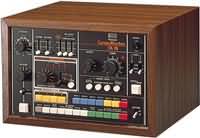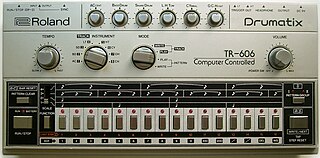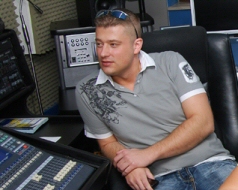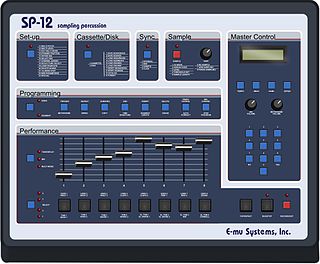Roland Corporation is a Japanese manufacturer of electronic musical instruments, electronic equipment and software. It was founded by Ikutaro Kakehashi in Osaka on April 18, 1972. In 2005, Roland's headquarters relocated to Hamamatsu in Shizuoka Prefecture. It has factories in Taiwan, Japan, and the USA. As of March 31, 2010, it employed 2,699 employees. In 2014, Roland was subject to a management buyout by Roland's CEO Junichi Miki, supported by Taiyo Pacific Partners.

A drum machine is an electronic musical instrument that creates percussion sounds, drum beats, and patterns. Drum machines may imitate drum kits or other percussion instruments, or produce unique sounds, such as synthesized electronic tones. Most modern drum machines allow users to program their own rhythms and beats. Drum machines may create sounds using analog synthesis or play prerecorded samples. Some drum machines have buttons or pads that allow the performer to play drum sounds "live", either on top of a programmed drum beat or as a standalone performance. Drum machines have a range of capabilities, which go from playing a short beat pattern in a loop, to being able to program or record complex song arrangements with changes of meter and style.

Digital music technology encompasses digital instruments, computers, electronic effects units, software, or digital audio equipment by a performer, composer, sound engineer, DJ, or record producer to produce, perform or record music. The term refers to electronic devices, instruments, computer hardware, and software used in performance, playback, recording, composition, mixing, analysis, and editing of music.

The Roland TR-808 Rhythm Composer, commonly known as the 808, is a drum machine manufactured by the Roland Corporation between 1980 and 1983. It was one of the first drum machines to allow users to program rhythms instead of using preset patterns. Unlike its nearest competitor at the time, the more expensive Linn LM-1, the 808 generates sounds using analog synthesis rather than playing samples.

A groovebox is a self-contained electronic or digital musical instrument for the production of live, loop-based electronic music with a high degree of user control facilitating improvisation. The term "Groovebox" was originally used by Roland Corporation to refer to its MC-303, released in 1996. The term has since entered general use, and dates back to the Movement Computer Systems Drum Computer in 1981.

The Roland TR-909 Rhythm Composer is a drum machine introduced by the Roland Corporation in 1983. It succeeded the TR-808, and was the first Roland drum machine to use samples and MIDI. Though it was a commercial failure, the 909 became influential in the development of electronic dance music such as techno, house and acid.

Novation Digital Music Systems Ltd. is a British musical equipment manufacturer, founded in 1992 by Ian Jannaway and Mark Thompson as Novation Electronic Music Systems. Today the company specializes in MIDI controllers with and without keyboards, both analog and virtual analog performance synthesizers, grid-based performance controllers, and audio interfaces. At present, Novation products are primarily manufactured in China.

The Roland CompuRhythm CR-78 is a drum machine launched in 1978.
Tadao Kikumoto is Roland's senior managing director and head of its R&D center. He designed the TB-303 bass synthesizer and the TR-909 drum machine. He was also the chief engineer of the Roland TR-808 drum machine.

The Jupiter-8, or JP-8, is an eight-voice polyphonic analog subtractive synthesizer introduced by Roland Corporation in early 1981.
Ikutaro Kakehashi, also known by the nickname Taro, was a Japanese engineer, inventor and entrepreneur. He founded the musical instrument manufacturers Ace Tone, Roland Corporation, and Boss Corporation, and the audiovisual electronics company ATV Corporation.

The Roland MC-505 is a groovebox conceived in 1998 as a combination of a MIDI controller, a music sequencer and a drum machine, and also has some of the prime features of synthesizers: arpeggiator, oscillators, voltage-controlled filter, control of attack, decay, sustain and release. It was released as the successor to the Roland MC-303 and is a compact version of the Roland JX-305 Groovesynth without the full set of 61 keys. It is also the predecessor to the Roland D2, Roland MC-307, Roland MC-909 and the Roland MC-808.

The Roland TR-606 Drumatix is a programmable analog synthesis drum machine built by the Roland Corporation from 1981 to 1984. It was originally designed to be used with the Roland TB-303, a monophonic analog bass synthesizer, to provide a simple drum and bass accompaniment to guitarists without backing bands.

The Roland JD-800 is a digital synthesizer that was manufactured between 1991 and 1996. The synthesizer features many knobs and sliders for patch editing and performance control – features that some manufacturers, including Roland, had been omitting in the name of "streamlining" since the inception of the Yamaha DX7. The JD-800 thus became very popular with musicians who wished to take a "hands on" approach to patch programming. In the introduction to the manual, it is stated that Roland's intention with the JD-800 was to "return to the roots of synthesis".
The Novation SuperNova, released in 1998, was a 3U rack-mounted virtual analogue polyphonic synthesizer with 16+ note polyphony and multitimbral operation, made by the British company Novation. Unique to the Supernova was the addition of multiple effects options which were retained per part in multi-timbral use, allowing a much richer sound than had generally been possible with a multitimbral synthesizer. The SuperNova and its successor, the SuperNova II, have been used by a wide range of artists including Orbital, ATB, The Faint, Ozric Tentacles, Sin, Jean Michel Jarre and A Guy Called Gerald.

Zachary Baird is a keyboardist, known for collaborating with the band Korn. He is also noted for using the Moog synthesizer, as well as the Ondes Martenot.

The R-8 Human Rhythm Composer is an electronic drum machine introduced in 1989 by Roland Corporation, using PCM voices. The R-8 features velocity- and pressure-sensitive trigger pads, and the ability to create loops of beats. The device has eight individual outputs, 12-voice polyphony, and four-part multitimbral MIDI.

Manuel Schleis (*1979) is a German music producer.

The Roland TR-707 Rhythm Composer is a programmable digital sample-based drum machine built by the Roland Corporation, beginning in 1985. The TR-707 was a staple in early house music, particularly with acid house. It is also a staple of almost all electronic Arabic pop music. Because the TR-707 offers a limited number of instruments sampled at 12 bits, its sound is considered dated by modern standards. However, it is still in use because of its versatility in synchronizing with other hardware and its fully featured interface, comparable to that of high-end Roland drum machines such as the TR-808 and TR-909.

E-mu SP-12 12 also known as the “sampling drum computer” was designed in 1985 and widely released in 1986 by E-mu Systems. Although the SP-12 was quickly superseded by the more powerful SP-1200, the SP-12 is often regarded as the first commercially successful drum machine and sampler.
















